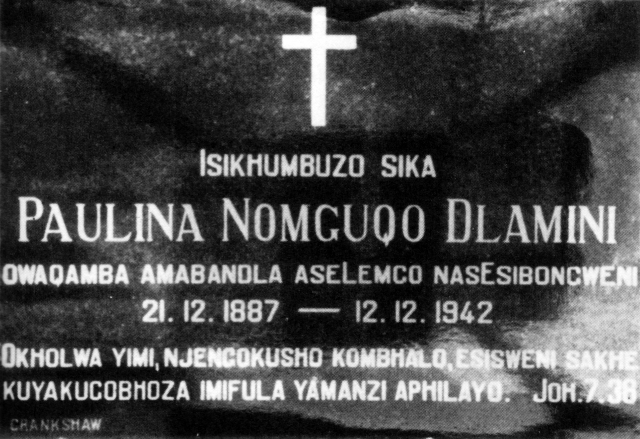
Paulina Nomguqo Dlamini (c1858-1942)Her Life and Work.
A SPOTLITE™ Presentation by Vic Berecz.

 |
Paulina Nomguqo Dlamini (c1858-1942)Her Life and Work. |
 |
|
The Zulu royal homestead was called an umuZi and a portion of it was set aside for the
isiGodlo ... the women of the king's establishment, from wives to serving girls. Most of them were given
to the king as tribute when teenagers. It was usually a lifetime committment. This is how Nomguqo, daughter
of a wealthy member of the Swazi royal family, came to crown-prince Cetshwayo's isiGodlo in 1872.
Soon thereafter, King Mpande died. We learn from Nomguqo about Zulu royal funeral customs, and the casual approach
to violence and death which extended from royalty to commoners. She notes that along with "... eating utensils and
weapons ... [the King's] man-servant, one or two wives, and some isiGodlo girls had to
follow him to the grave." Cetschewayo "was not rash in condemning people to death" yet he executed
a young girl who had the misfortune that: "One of the king’s beer ladles broke in her
hand ... he consulted the diviners [and] she was taken to the place of execution forthwith!"
The Zulu religion was based on ancestor spirits which could intervene in the lives of people for both good and evil.
Nomguqo tells us: "The spirits of the ancestors (amadlozi) were invoked by animal sacrifices." and
“The male spirit was represented by a snake, the female by a lizard." So, specific species of these
creatures had to be shown due respect by all.
The isiGodlo women also were the king's concubines. While her Victorian and Christian sensibility forbade
open talk about sexual practices and celebrations in the royal household, Nomguqo admitted that at the time
"these gave us much joy and pleasure".
As Cetshwayo fled Ulundi in 1879, the 11-year old Prince Dinuzulu was placed in Nomguqo's care. She and other women
escaped with the children and delivered them to royal relatives. After hearing of Cetshwayo's capture,
she made her escape. Now unexpectedly free, Nomguqo returned to her family. |
The disruption of traditional life, and the civil strife after the Anglo-Zulu War left her family destitute. Nomguqo soon found herself indentured as a house-servant for a deeply religious Boer farmer named van Rooyen in the Ehlanzeni area. While there, she had strange dreams which she deemed to be "visitations by the Lord". Nomguqo dreamt of a messenger dressed in white exhorting her to accept the Bible and to go out and teach her people. She woke van Rooyen and described her dreams. He made missionary Johannes Reibeling aware of Nomguqo's visions and in the autumn of 1887 she was sent to Ehlanzeni. [Of course, Reibeling had to send a Zulu girl to van Rooyen to do her work.]  Paulina with the Reibelings on the day of her baptism. Three months later, on the day of the dedication of the new Ehlanzeni church, she was baptized taking the Christian name Paulina. She studied at the Ehlanzeni seminary for almost two years under Reibeling and his son Louis, who in the spring of 1888 returned from school in Neu Hermannsburg to assist his father. The program included: "Biblical History, the Catechism, Reading the Bible, and a number of worldly subjects, such as History, Geography, Nature Study, Arithmetic, Singing, and yes ... even the English and Dutch languages." |
Paulina returned to the van Rooyen's (who by now had purchased a farm in Zululand) and began
her career as an evangelist while living with them. As she began gathering a flock, she and van Rooyen conducted
services in his home ... he preaching to the whites, she to the blacks. This group was the basis of the congregation
at Lengo, to which Reibeling later sent a seminary graduate as a full-time evangelist. She continued gathering
converts in the area, despite several failures. Twice Reibeling and his two sons came to Zululand to baptize
those Paulina had taught. Among those she converted were two wives of King Dinuzulu. Another
success was the congregation at Esibongweni, where Rev. Heinrich Filter worked with Paulina.
She spent most of her later years living and working at the Lengo mission station.
There was often regression among Zulu Christians. Of this Paulina said, "We Zulus have many customs which make it
difficult to decide if they are objectionable heathen customs, or simply innocuous and compatible with life in a
Christian congregation." Thus life continues to this day among many Zulu Christians.
Late in life, Paulina providied her memories to Pastor Filter, then serving at
the Nazareth station. His German notes were used to produce the book Paulina Dlamini - Servant of Two Kings
which is available at Amazon and elsewhere. It provides a unique picture of Zulu life from
a woman's perspective. Below is a 1938 photo of Paulina and a picture of her gravestone. Note that
it gives her birthdate as 21 December 1887 ... the date of her baptism ... her rebirth as a servant
of Jesus Christ. 
 |